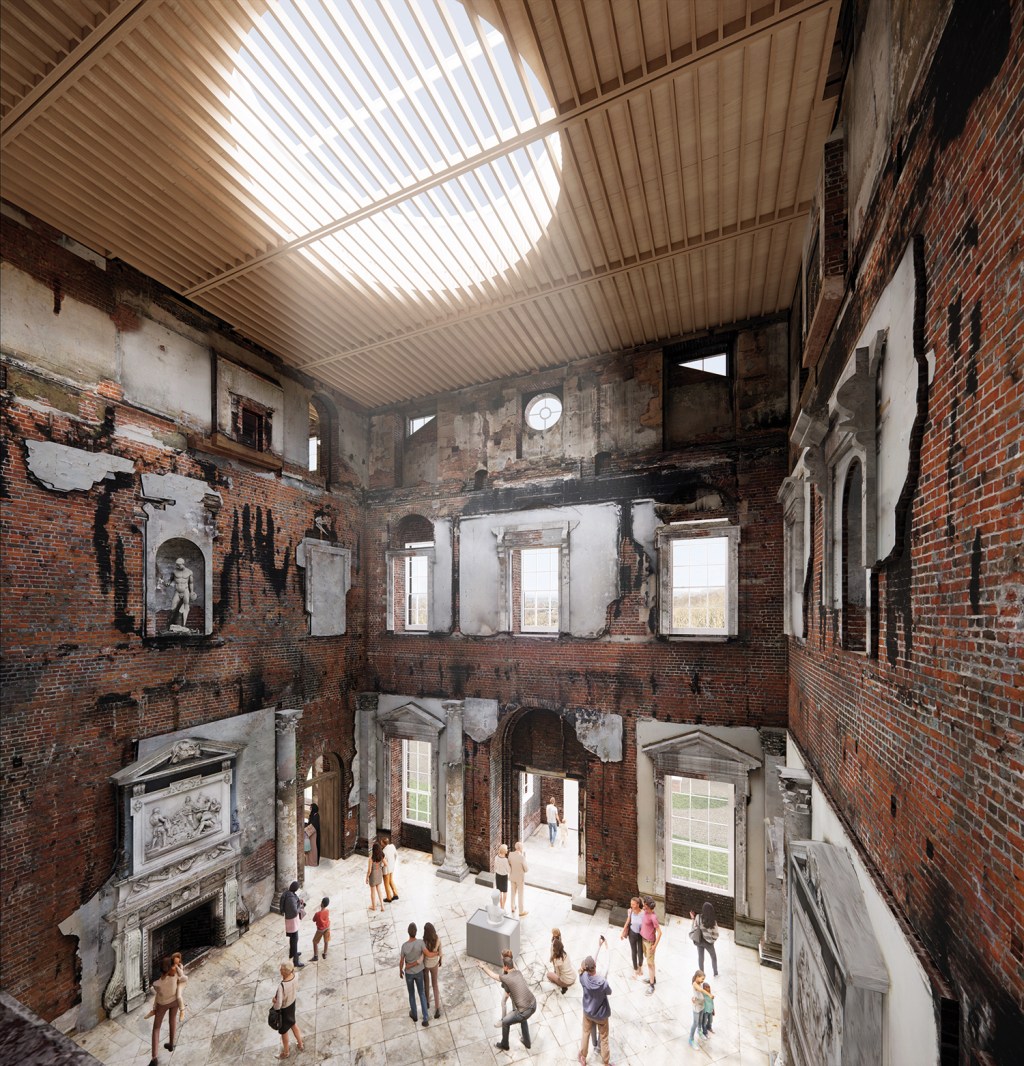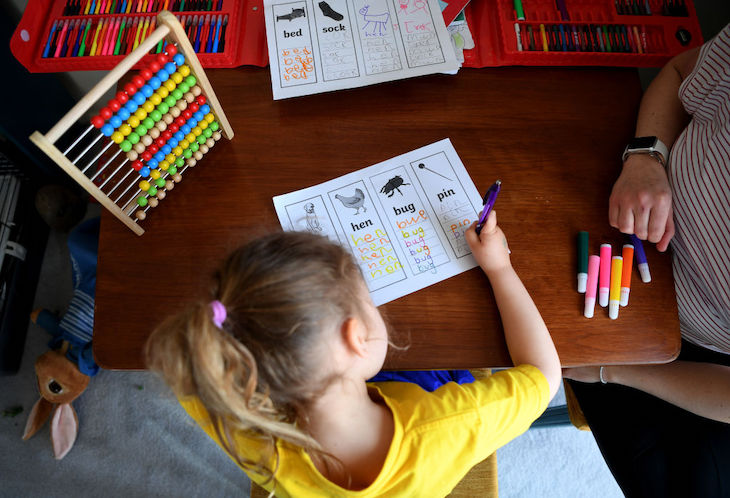In April 2015, a fire raged through Clandon Park, destroying much of the 18th-century Palladian mansion’s prized interiors. Contrary to all expectations, the National Trust, its custodian, announced plans to keep the Grade I-listed building ‘as a ruin’. Architects Allies and Morrison would ‘creatively curate’ the celebrated property as ‘a country house laid bare’, adding a modern roof and walkways, but otherwise leaving the interior in its half-charred form. Last month, Guildford Council waved through the plans unanimously.
It was a landmark decision. Without any fanfare, a sweeping precedent was set for how we restore damaged buildings – one that throws out the lauded example set by Windsor and Notre-Dame – with incendiary implications for our architectural heritage.
The conundrum of conservation is architecture’s Ship of Theseus: how much of a historic building can be restored before it becomes a different building entirely? The thought experiment embodies a perpetual debate among conservationists: whether a building’s essence lies in the bricks and mortar, the form, or something else. Might not the craft culture that comes with a building be as important as the material artefact itself? As a provocative example, look at Japan’s Ise Shrine, which has been rebuilt every two decades for the past 1,300 years, a ritual that enables the original design and artisanry to be passed down to each new generation.
A nuanced compromise is usually the answer. Not for the National Trust, however. With Clandon, the Trust toes the party line of the Society for the Protection of Ancient Buildings (SPAB), which was founded by William Morris in 1877 in opposition to how Victorian architects were restoring cathedrals. The scathing SPAB manifesto dismissed these ‘conjectural restorations’ as a ‘feeble and lifeless forgery’ and called instead to ‘resist all tampering with either the fabric or ornament of the building as it stands’, preserving buildings as ‘monuments of a bygone art’. True to its founding spirit, SPAB’s official endorsement of the Trust’s proposals still values ‘fabric’ above all, arguing a reconstruction would be ‘of little worth and falsify evidence’.
Not so, says the Georgian Group, one of the only statutory consultees that dissented to the Trust’s proposal. ‘Clandon’s architectural distinction lies in its original design – its internal spatial relationships, the extraordinary craftsmanship of its principal interiors – not in burnt bricks,’ explains Dr Anya Lucas, the Georgian Group’s director. After all, old buildings are not mere archaeological sites.
Central to Clandon’s heritage value is the design vision of its architect, the Venetian Giacomo Leoni. Leoni was pivotal in reviving England’s interest in the architectural styles of the Italian Renaissance, having illustrated and published influential English translations of Andrea Palladio and Leon Battista Alberti’s key architectural texts in the early 1700s. Clandon remained, until the fire, the most complete example of his work from this crucial period. As Lucas describes, ‘Clandon demonstrates Leoni’s talent for translating Italian Renaissance designs – via local influences – to the English countryside.’
The Trust says visitors should be content with a virtual reality experience of what was left
Yet the Trust, in fetishising its incinerated state, fixates on material forensics at the expense of preserving Leoni’s intent as an architect. In fact, objectors point out that the proposals actively undermine it. By opting for walkways rather than reinstating the floors, the spatial contrasts between the cubic Marble Hall and the Palladian proportions of the Palladio Room are lost to a meaningless spectacle of a triple-height shell. Whereas Leoni took pains to create an innovative roof structure to ensure it remained hidden from the outside, they introduce a roof terrace, cluttered with a café kiosk, lift and stairs. The surviving fabric becomes a glorified viewing platform – not in order to see Capability Brown’s picturesque landscaping (which was designed to be framed from within the house) but to take in a very unremarkable view of suburban Guildford.
The greatest loss is the creative partnership between Leoni and his craftsmen, especially Giuseppe Artari, the famed stuccadore who executed Clandon’s celebrated plaster ceilings. Tragically these will live on as circular skylights – the original plaster roundels and their mythological potency reduced to a sad banality. The Trust has ruled that a faithful reconstruction is not feasible, and visitors should be content with virtual and augmented-reality experiences of what was lost.
This vote of no confidence in British craft has drawn the rebuke of the Traditional Architecture Group, which hosts Britain’s chapter of the International Network for Traditional Building, Architecture & Urbanism (INTBAU), the network founded by the King to nurture building traditionally, from design to construction. It points to successful precedents of post-fire reconstruction, most prominently Notre-Dame, but also Uppark closer to home, another Trust property that, in 1989, was ravaged by fire. Back then the Trust took the decision to use the insurance payout to faithfully reconstruct the original. This created a new generation of craftsmen who are still practising today. It’s a reminder that buildings are not just artefacts, but living economies. As Simon Jenkins proclaimed at the time: ‘Uppark is more than a house restored. It is an argument won.’
The Trust’s defeatism on Clandon Park is unfortunately a self-fulfilling prophecy: there certainly won’t be the restoration skills if leading heritage bodies throw away major opportunities to bring in new blood. The classical architect Francis Terry, who has sustained these trades through projects such as the reconstruction of Castle Howard’s Tapestry Drawing Room, believes an authentic reconstruction ‘is well within the abilities of the craftsmen we have working in the UK today – we still have some of the best in the world’.
For him, the first step would be to create large-scale drawings of the decorative scheme from the visual records available. The Trust claims that ‘there is insufficient photography and measurements to replicate using digital technology’. Yet even in war-torn Mosul and Palmyra, technology such as Rekrei can use photogrammetry to piece together detailed 3D models of destroyed heritage from crowdsourced tourists’ photographs. For a building like Clandon that has been photographed profusely as a visitor destination and wedding venue, and that’s been in the Trust’s care for almost 70 years, evidence is abundant: its reconstruction does not need ‘conjecture’, but willpower.
Philip Gaches, a conservation plasterer who honed his craft under leading masters at Windsor Castle’s restoration after its 1992 fire, sees huge potential in restoring Clandon. He could ‘recruit ten new workers’ plus ‘educate a hundred more through practical experience days’. Trying to plug skill shortages is a perpetual battle within the construction industry, especially within his niche market. ‘When we are engaged on large projects, it gives us the confidence to take on trainees.’
The reconstruction of Uppark created a new generation of craftsmen who are still practising today
While planners assume unspecified economic benefits for the Trust’s proposals, the job creation of a barista for its rooftop café is trivial compared with the opportunity – unique to Clandon – of being able to train new master craftsmen. ‘The responsibility to care for the buildings [in the Trust’s portfolio] comes with a responsibility to ensure those skills are in place,’ adds Gaches. Even new-builds would benefit: lime plastering is already being rediscovered and resurrected in construction’s push for sustainability.
The approval of the Trust’s plans also reflects on the perversity of planning procedure. Conservation is tricky to codify, because for Terry, ‘you need people in power to have taste and judgment, not just apply a blanket policy’. Planning committees are intended as moments for democratic deliberation. In reality, councillors are put in an impossible position. As one councillor admitted at the meeting, ‘I am not an architect, I am not an architectural historian’, yet they were asked to absorb the history of Leoni and Palladian revival, judge legalistic planning arguments, and even opine on the question of whether a restoration would be ‘fake’ or not, in a stilted discussion where speakers were limited to three minutes each. Worryingly, the new planning bill proposes letting unelected planning officers take over from committees in more decisions, in a bid to accelerate building. Clandon is a warning that for historic places, much deeper scrutiny is needed.
The concern now is that Clandon becomes, according to Lucas, ‘a dangerous precedent’. The approval hinged on a loophole where the Trust convinced planners that the proposals should be judged on what remained of Clandon after it had been hollowed out by flames. Yet by that benchmark, anything, even the Trust’s proposals, can be made to feel like an improvement. ‘In our view, by assigning a positive value to the burnt interiors, they are adopting an extreme and illogical position,’ Lucas adds. ‘And if this approach can be adopted for a Grade I-listed building, what does it mean for the rest?’
The last hope is for the decision to be called in by the secretary of state. A rigorous review may be a good opportunity to reflect on whether Clandon’s destruction by fire from a faulty fuse-box should be, to quote the Trust’s founding statute, ‘permanently preserved for the benefit of the nation’ over its true ‘beauty or historic interest’. It may otherwise end up as not even a ‘monument of a bygone art’, but a monument to the failure of the National Trust.























